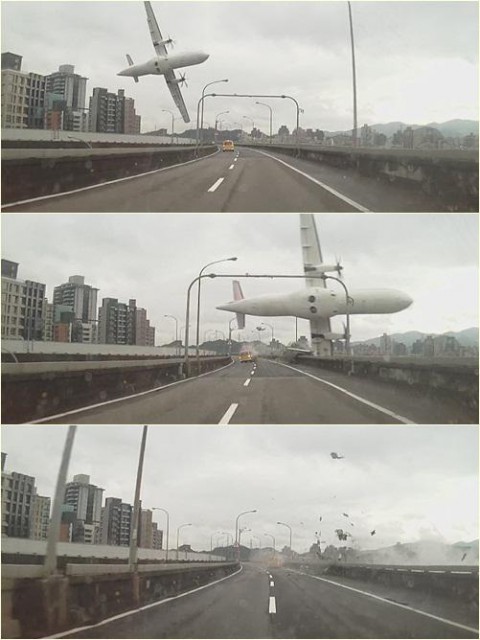
A TransAsia ATR crashes – Photo: @Missxoxo168
UPDATE 2/4/15 7:00AM PST: The Associated Press is reporting that the death toll from the accident has risen to 25, with 18 people still unaccounted for. Per civil aviation authorities in Taiwan, the pilot had logged nearly 5,000 flight hours. The cockpit voice recorder and flight data recorder (“Black Boxes”) have been recovered, which should assist authorities in determining the cause(s) of the crash.
ORIGINAL STORY:
TransAsia Flight 235 (GE235), an ATR72-600, has crashed during takeoff while en route from Taipei Sung Shan (TSA) to Kinmen Shang-Yi Airport (KNH), in the Fujian Province. The aircraft, reg# B-22816, was only 10 months old at the time of the crash.
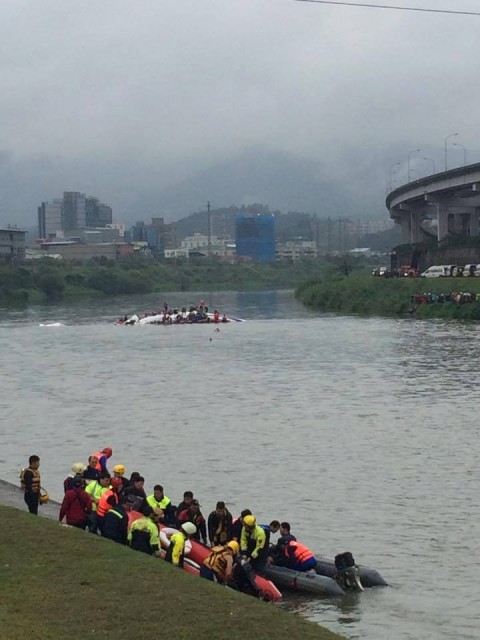
Rescuers and passengers can be seen on the bank with the TransAsia ATR72 in the background – Photo: Yung Jen
Video and photos show the aircraft at a steep angle flying over an overpass and then into the Keelung River. At the time of this update, there have been three reported passenger deaths with another few injured.
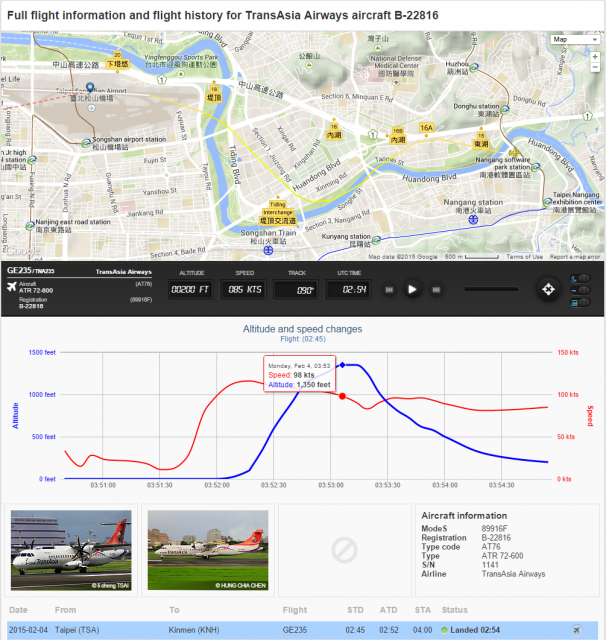
The flight path of GE225 shown – Image: FlightRadar24
FlightRadar24.com is showing that the aircraft was only airborne for about three minutes before trying to turn back and crashing. ATC recordings state that the flight called a mayday, reporting an engine flame out (23:25 – in Mandarin).
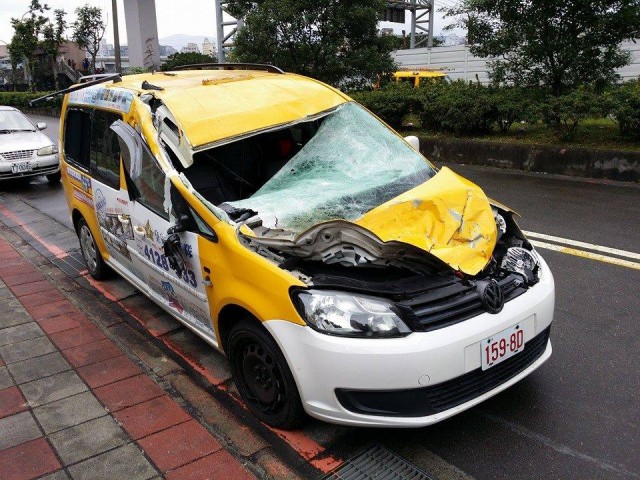
The taxi cab hit by the ATR-72 seen after being moved – Photo: Eddie Yu
Here is a video that shows the ATR crashing over the roadway:
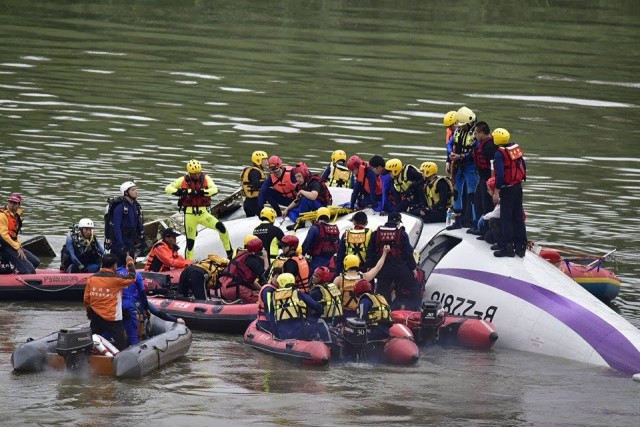
Rescuers are on top of the crashed ATR-72 – Photo: Eddie Yu
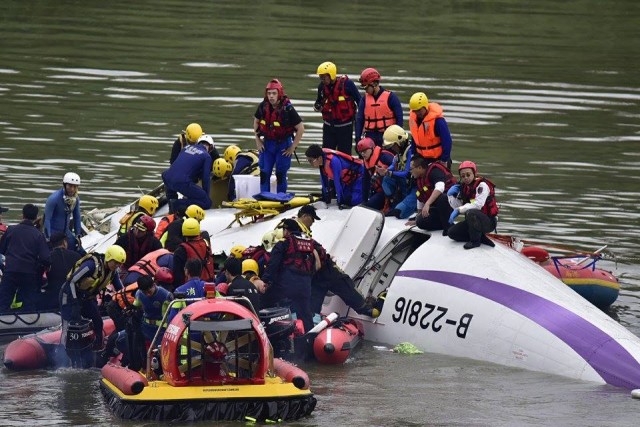
Another look at those who are trying to find the cause of #GE235’s crash – Photo: Rescuers are on top of the crashed ATR-72 – Photo: Eddie Yu
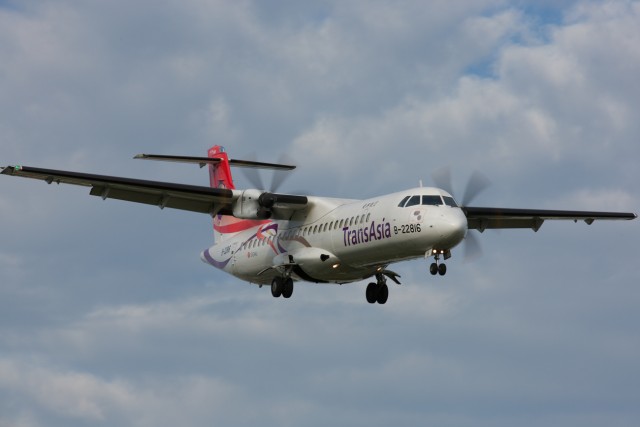
Here is the aircraft in question, B-22816, taken December 14th – Photo: Jeremy Dwyer-Lindgren | JDL Multimedia
This is a developing story and will be updated as we receive new information.
That is a scary shot, much closer of a shot than what I saw on our local news. My thoughts and prayers go out to the people and families of the people of Taiwan.
o my god…..
again 🙁 after air asia now TrasAsia
$10 says the cab driver is at the mall looking for a new pair of fruit of the looms!
Ouch, not a great year for ATR, another one of their planes going down.
This video shows a closer view, I believe it may be the source for the close-up stills shown at the beginning of this post:
https://youtu.be/eJNAx4BsUtE
Anyone know the flap speeds (Vf Vfe) for an ATR72?
Flaps appear retracted in the still photos.
http://www.arabianaerospace.aero/atr-top-of-the-props.html
Lists V1 & Vr as 105kt, & V2 as 112kt. Couldn’t find any other numbers.
The stall speed clean on this thing is around 100 knots, and around 80 knots dirty. Looks like a stall spin accident.
Looking at the video that RGB posted, it looks like the pilot was lined up to ditch in the river, but rolled left at the last second. Could it be because he saw the high power electrical lines stretching over the freeway and across the river? It looks like the plane would have gone right into them if it had maintained its path.
Never mind that – this video showing the aftermath of the crash reveals that there was no space at all in the river for a ditch, and the pilot could just as well have been trying to avoid crashing into the houses on the other side of the river (0:12 mark). He had nowhere to go, but the fact that he was able to avoid any other ground casualties in this extremely densely populated area is a testament to piloting skill and a degree of luck.
Forgot video link: https://www.youtube.com/watch?v=43lFllZ7ehY
left wing stalled. Check the airspeed. No airspeed – no control.
Inferring from the radar data (plotted above), it looks like the airspeed was stable and by the book during initial climb out, then begins to drop. You can see the airspeed dropping as the rate of climb flattens out. This is followed by a quick drop in airspeed and a rapid drop in altitude – stall? Then, the airspeed picks up and levels while the altitude begins to roll out, indicating that maybe the pilot nosed over to pick up some maneuvering speed. Looking at the video: In the end, the pilot’s faced with either slamming into the elevated highway or probably pulling back on the stick to try to miss the road and put the craft in the river. At this low speed, the craft most likely stalls, in this case a stall on the left wing which causes the plane to roll left, clipping the bridge. Tragic accident, but given the development density around this airport (try Googling Songshan Airport and turning on the satellite view to see what I mean), the pilot did a remarkable job avoiding added tragedy.
I am not an expert much, but my experience from previous observation of aircraft accidents especially in Asia, poor maintenance is the main cause of most crashes. That airplane could have a problem with the tail section that made it difficult to climb and to keep things stable. I say that engines were in good conditions, but the control system seemed unstable and I think that the tail especially the rudder is one of the main issues. Over all, airplanes with good maintenance = nice and peaceful flights.
I think the engines were the problems not the control system since we saw the video how the airplane was stalling till it crashed. The pilot reported few seconds before crash that there was an issue with engines. That could be because of poor maintenance!
If we look at the video online and see how that airplane crashed, you will see that it was stalling. It could be overload or not enough speed to fight back the gravity while climbing besides a bad weather.
Any mathematicians out there who can calculate the odds of your taxi being struck by a crashing plane and living to tell about it.
Milliseconds from sure death!
This is from my observation from still shots off the video…I could be wrong. The left engine appears to be feathered and/or turning slower than the right side. Now with the mayday call of engine flame out during take off, it’s highly plausible that it experienced an EFATO and couldn’t recover as it had to clear those tall buildings.
1. There is an updated Flightradar24 map (http://pbs.twimg.com/media/B9BnxCrIAAAoIvi.png) showing a more accurate position of the crash, which is consistent now with the multiple dashcam recordings.
2. ATC recording with the ‘mayday flame-out call’ are in English (albeit accented) not Mandarin.
3. It’s speculation but from the Flightradar24 track it looks like after the engine failure the pilot may have first considered a forced landing on the Zhong Shan No.1 Freeway which is wide enough but very unlikely to have been devoid of traffic at that time of the morning and thus elected for a ditching in the Keelung river before experiencing a port wing-tip stall and hitting the taxi and elevated expressway.
Based in my flying experience, this accident perhaps occur due a loss of power of the left engine, which lead to a loss of control in single engine condition. Possibly the pilot not have time to compensate, or simply cut the troubled engine. But another factors can be happen, only de Investigation can be precise the exact causes. In all, a tragic loss to all world aviation comunity!
Looks like no takeoff flaps (15 deg. recommended) were deployed. Left engine fails at V1. Pilot kicks right rudder. Airplane is doomed.
The pilot was losing altitude for over a minute before crashing. It doesn’t look like he kicked left rudder after losing power. I think that we need to know more about his takeoff weight before we can conclude that the remaining engine was capable of keeping the plane aloft. Given that the track the plane follows after onset of the emergency, the pilot looks to have had some control of a descending plane and was exercising what control was available until the end.
I meant to say “left rudder”.
One generally does not declare “mayday” upon losing power on an engine. This guy was dealing with more than one mistake. The “no flap” minimal lift at a V1 set for 15 degrees of flaps will be a smoking gun. Brain farts kill.
The crew may have turned off the wrong engine.
Yeah, I heard that early today. That is the worst mistake imaginable in any thing but a glider.